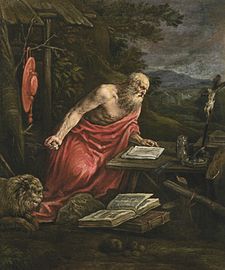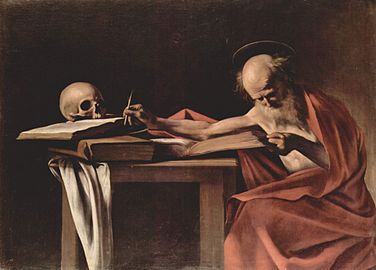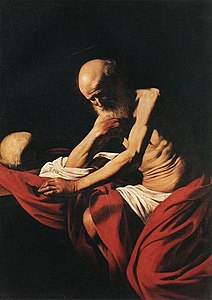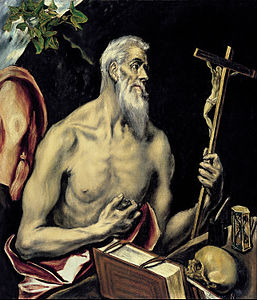Jerome (saint)
Eusebius Hieronymus (Latin, Eusebius Sophronius Hieronymus; Greek, Ευσέβιος Σωφρόνιος Ίερώνυμος) (Estridón, Dalmatia, c. 340-Bethlehem, September 30, 420), commonly known as Saint Jerome, but also as Jerónimo de Estridón or simply Jerome, is a Christian saint and father of the church, who translated the Bible from Greek and Hebrew into Latin on behalf of Pope Damasus I. The Latin translation of the Bible made by Saint Jerome, called the Vulgate (from vulgata editio, 'edition for the town') and published in the IV century of the Christian era, it was declared in 1546, during the Council of Trent, the authentic edition of the Bible for the Latin Catholic Church.
Saint Jerome was fluent in Latin, his mother tongue, and had an in-depth knowledge of the classical rhetoric of that language, he also had a good command of Greek and knew some Hebrew when he began his translation project, although he moved to Bethlehem to improve their knowledge of that language. In 382, he corrected the existing Latin version of the New Testament, and in the 390s he began translating the Old Testament directly from the Hebrew (he had already translated fragments of the Septuagint from Alexandria). He completed his work in the year 405.
If Augustine of Hippo deserves to be called the father of Latin theology, Jerome is the father of biblical exegesis. With his works, resulting from his remarkable scholarship, he exerted a lasting influence on the manner of translation and interpretation of the Holy Scriptures and on the use of ecclesiastical Latin. [citation needed ]
He is considered one of the Fathers of the Church, together with Ambrosio, Agustín and Gregorio one of the four Latin Fathers, and a doctor of the Church. He is also recognized as a saint by the Catholic, Orthodox, Lutheran and Anglican churches.[citation needed]
In his honor, International Translation Day is celebrated every September 30.[citation required]
Biography
He was born in Estridón (oppidum, later destroyed by the Goths in 392) on the border of Dalmatia and Pannonia, between the years 331 and 347, according to different authors; rather mid-century, since he was a child when Emperor Julian the Apostate died. His parents were Christians with some means of fortune, and Jerome, whose name means 'he who has a sacred name', although he had not yet been baptized, as was customary at the time, was enrolled as a catechumen and will consecrate all his life to the study of the Holy Scriptures, being considered one of the best, if not the best, in this trade.
He left at the age of twelve for Rome with his friend Bonosus to continue his studies in grammar, astronomy and literature under the greatest Latin grammarian of his time, Elio Donato, who was a pagan. There the saint became a great Latinist and a very good connoisseur of Greek and other languages, but at that time he knew very little about spiritual and religious books. He spent hours and days reading and memorizing the great Latin authors, Cicero (who was his main model and whose style he imitated), Virgil, Horace, Tacitus, and Quintilian, and the Greek authors Homer and Plato, but he rarely spent time on spiritual reading. He made friends there with Rufino de Aquileia and Heliodoro de Altino, and frequented the theater and the Roman circus. Around the age of sixteen he took courses in rhetoric, philosophy and Greek with a rhetor and asked for baptism around the year 366 AD. C. he traveled with Bonosus to Gaul around 367, and settled in Trier, "on the barbarian shore of the Rhine." There he began his theological vocation and compiled, for his friend Rufino, the Commentary on the Psalms by Hilary of Poitiers and the treatise De synodis , where he discovered the rising monasticism. He then remains for some time, perhaps many years, in a cenobitic community with Rufinus and Chromatius of Aquileia, and at that moment he breaks his relationship with his family and affirms his will to consecrate himself to God. Some of his Christian friends accompany him when he makes a journey, around 373, through Thrace and Asia Minor to stop in northern Syria. In Antioch, two of his companions die and he himself falls seriously ill several times. In the course of one of these relapses (winter of 373 or 374), he has a dream that makes him definitively abandon his profane studies and consecrate himself to God. In that dream, which he narrates in one of his Letters, he is reproached for being “a Ciceronian, and not a Christian”. After this dream, he renounced the study of the profane classics for a long period of time and delved into the Bible under the impulse of Apollinaris of Laodicea. He also teaches a group of women in Antioch, being undoubtedly a disciple of Evagrio Pontico. He studies the writings of Tertullian, Cyprian of Carthage, and Hilary of Poitiers.
Desiring intensely to live in asceticism and do penance for his sins, Jerome marched to the Syrian desert of Qinnasrin or Chalcis (the Syrian Thebaid), located southwest of Antioch. He especially rejected his strong sensuality, his terrible temper and his great pride. But although there he prayed a lot, he fasted and spent sleepless nights, he did not get peace and discovered that he was not made for such a life because of his ill health: his destiny was not to live in solitude:
I, who for fear of hell had imposed a prison in the company of scorpions and bandages, often believed to attend the dances of maidens. I had the face impaled by fasting; but the spirit burned with desire my frozen body, and the fires of voluptuousness believed in an almost dead man. I remember it well: I sometimes had to scream without rest all day and all night. He kept hurting my chest. My cell inspired me a great fear, as if I were accomplice of my obsessions: furious with myself, I fled alone into the desert... After praying and wept a lot, I came to believe in the choir of angels.Letter XXII to Eustoquia.
It was at that time in Antioch that he began to be interested in the Gospel of the Hebrews, which was, according to the people of Antioch, the source of the Gospel according to Saint Matthew. Moreover, at this time he began his first commentary on Biblical exegesis on the smallest book of the Old Testament, the Book of Obadiah , for which he took the time to learn Hebrew well with the help of a Jewish:
I put myself under the discipline of a certain Jewish brother, converted after the high concepts of Quintilian, the broad periods of Cicero, the gravity of Frontino and the charms of Plinius; I learned the Hebrew alphabet, exercising to pronounce the sybilants and the gutures. How many fatigues I suffered! I often despaired of reaching my goal: everything abandoned. Then, decided to defeat, he resumed the fight. Witnesses of this are my conscience and those of my companions. However, I thank the Lord for bringing forth such sweet fruits from the bitterness of such initiation into the letters.Letter CXXIV, l2.
He then translated the Gospel of the Nazarenes, which he considered for some time to be the original of the Gospel according to Matthew. In that period he also began his abundant Epistolario .
On his return to Antioch, in 378 or 379, he was ordained by Bishop Paulinus of Antioch and shortly afterwards left for Constantinople to continue his studies of the Holy Scriptures under the aegis of Gregory of Nazianzus, but also to avoid quarrels theological differences between the supporters of the creed of the Council of Nicaea and Arianism. He stayed there for two years following the courses of Gregorio, whom he describes as his tutor. It is in this period that he discovers Origen and begins to develop a trilingual biblical exegesis, comparing the Latin, Greek and Hebrew interpretations of the Bible text. And he translates into Latin and completes the chronological tables of the Chronicle of Eusebius of Caesarea, a universal history from Abraham to Constantine.
He returned to Rome in 382 and stayed there for three years. The bishops of Italy, together with the pope, appointed St. Ambrose as secretary of the latter, but he fell ill and later chose Jerome, a position he carried out very effectively. Seeing his skills and knowledge, Pope Damaso I appointed him his secretary and commissioned him to write the letters that the pontiff sent. And later he appointed him to compile the Bible and translate it. Then, Jerome discovered his true vocation, with which he could serve God: that of a philologist. The translation of the Bible circulating in the West at that time (currently called Vetus Latina ) had many variants, language imperfections and inaccuracies or not very accurate translations. Jerome, who wrote Latin with great elegance, translated the entire Bible into this language, in the translation called Vulgate (lit. "the one in common use").
During his stay in Rome, Jerome officiated as spiritual guide for a group of women belonging to the Roman aristocracy or patriciate, among whom were the widows Marcela and Paula of Rome (the latter, mother of the young Eustoquia, whom Jerome addressed one of his most famous epistles on the subject of virginity). He initiated them in the study and meditation of the Holy Scripture and in the path of evangelical perfection, which included abandoning the vanities of the world and developing works of charity. That center of spirituality was located in a palace on the Aventine Hill, where Marcela lived with her daughter Asella. The spiritual direction of women earned Jerome criticism from the Roman clergy, which even reached defamation and slander. However, Palladio affirms that the link with Paula of Rome was useful to Jerome in his Biblical works, since his father had taught him Greek and had learned enough Hebrew in Palestine to sing the psalms in the language. original. It is a fact that much of Jerónimo's correspondence was addressed to different members of that group, which would later be joined by Fabiola de Roma, a young divorced and remarried woman who would become one of Jerónimo's great followers. Several members of this group, including Paula and Fabiola, also accompanied Jerome at different times during his stay in Bethlehem.
At the Council of Rome in 382, Pope Damasus I issued a decree known as the Decree of Damasus which, according to some authors, contained a list of the canonical books of the Old and New Testaments. He asked Saint Jerome to write a new translation of the Bible, in order to end the differences that existed with the version of the Bible that circulated in the West, the so-called Vetus Latina . He then began this work with the translation of the Psalms or Psalms . And he also translated, at the express request of Pope Damasus, the Commentaries on the Song of Songs by Origen and the treatise On the Holy Spirit by Didymus the Blind.
When he was in his 40s, Jerome was ordained a priest. But his high positions in Rome and the harshness with which he corrected certain defects of the high social class brought him envy, which intensified when his protector, Pope Damasus, died. Feeling misunderstood and even slandered in Rome, where they did not accept his energetic way of correction, he decided to leave there forever and went to the Holy Land, arriving in Antioch in August of the year 385 accompanied by his brother Paulinian and some friends. Jerome thus obeyed a canon of the Council of Nicaea that established that priests were in their dioceses of origin. He was followed soon after by Saint Paula and Eustoquia, determined to leave their patrician environment to end their days in the Holy Land. The pilgrims, received by Bishop Paulinus of Antioch, visited Jerusalem, Bethlehem and the holy places of Galilee. They met Melania the Elder and Rufinus of Aquileia, a friend of their youth, in Jerusalem, where they led a life of penance and prayer in monasteries that Jerome cites in his Letters. In a commentary on Zephaniah (prophet) I: 15, he took up the accusation of deicide against the Jews formulated in the patristic corpus: «This day is a day of fury, a day of anguish and distress, a day of uproar and desolation, a day of clouds and shadows...» And he mentions the habit of the Jews to go to cry at the Wailing Wall: «Until this day, these hypocritical tenants are forbidden to come to Jerusalem, since they are the murderers of the prophets and above all of the last among them, the Son of God; unless they come to cry, because they were given permission to mourn over the ruins of the villa, for a fee."
During the winter of 385 to 386, Jerome and Paula left for Egypt, since that was the cradle of the great models of ascetic life. In Alexandria, Jerome was able to see again the catechist Didymus the Blind explain the prophet Hosea and recount the memories he had of the ascetic Antony the Great, who had died thirty years before.
In 386 he returned to Bethlehem, where he founded a community of ascetics and scholars and spent his last 35 years in a grotto. This cave is currently in the moat of the Church of Santa Catalina in Bethlehem. Several of the rich Roman matrons, whom he had converted with his preaching and advice, sold his goods and also went to Bethlehem to continue under his spiritual direction. With the money from those ladies, he built in that city a convent for men and three for women, and an inn to serve those who came from all over the world to visit the place where Jesus of Nazareth was born.
He built and developed his monastery for three years thanks to the means provided by Paula. She directed the women's monastery and Jerome the men's, although he assumed the spiritual direction of both the men and the women through the exegesis of the Scriptures, the exposition of which had a prominent place in the community life regulated by Jerome. Jerome assimilated the Bible to Christ and wrote: "Love the Holy Scriptures and wisdom will love you, it is necessary that your tongue knows only Christ, that it can only say what is holy". write an education manual for Paula's granddaughter: «Make her letters out of boxwood or ivory, and call them by name; that she have fun with it, so that her fun is also a lesson for her..., that joining syllables deserves a reward, that in this way she will be stimulated with the small gifts that can delight at that age ». And her advice continues: «Let her have fellow students whom she can envy, whose praise incites her. Let her not be scolded if she is a little slow, but rather stimulate her mind with compliments; may she discover joy in success and failure in trouble. Make especially sure that she does not dislike her studies, because the bitterness she feels in childhood could last beyond the apprenticeship years."
In his correspondence with some Romans who asked him for advice, Jerome shows the importance he attached to community life: «I would prefer that you were in a holy community, that you did not teach yourself and not commit yourself without a teacher in a vow completely new for you”, recommending moderation in bodily fasting: “Improperness will be the index of the sharpness of your soul... A modest, but reasonable, nutrition is beneficial for body and soul”, as well as avoiding idleness: “ Reserve a little manual work, so that the devil always finds you busy», ending his advice with the maxim: «Christ is naked, it is the naked. He is tough, he is great and difficult; but the reward for it is magnificent.
In Bethlehem, he deepened his knowledge of Hebrew by following the courses of Rabbi Bar Anima and studying the different writings of Origen, as well as the Old Testament in Greek and Hebrew, in the Caesarea library in Palestine. Jerome developed commentaries on Ecclesiastes; for this he relied on different interpretations in order to discover the literal meaning and then make comments. At the request of Paula and Eustoquia, he translated the Epistle to the Galatians and then did the same work with the Epistle to the Ephesians and the Epistle to Titus .
In 389 he interrupted his work on the Pauline Epistles in order to begin the translation of the Psalter. He begins the translation of the Book of Nahum. He then developed his method of exegesis, borrowed largely from Origen: translating the book in its different versions to then give a historical, then allegorical and finally spiritual explanation. He used his commentaries on the Bible to respond to the theology of Marcion, who had questioned the unity of the God of the Old Testament and the New Testament. He writes the commentaries on the Book of Micah , on the Book of Zephaniah , on the Book of Haggai and on the Book of Habakkuk .
From 389 to 392, Jerome works on the Latin translation of the Bible Septuagint, using the Hexapla technique of Origen and, again at the request of Paula and from Eustoquia, translates the 39 homilies of Origen and criticizes the writings of Ambrose of Milan, who uses Origen's writings in misleading translations. His Biblical research led him to elaborate an onomastic index or Onomasticon of Hebrew personal names and a Hebrew toponymic index of place names, continuing the initiative of Rabbi Philo of Alexandria and thus complementing the already elaborated by Eusebio. This study supposed the important novelty in the biblical exegesis of Christianity of using Hebrew and rabbinic traditions in order to better understand the meaning of some passages of the Bible, a novelty that was not followed by those who used only the Greek version of the Bible, the Septuagint, in exegesis.
With tremendous energy he wrote against different heresies. But a dispute over Origen's doctrine (and more specifically over the translation of Origen's Treatise on the Principles, considered heretical) pitted Jerome against his compatriot and dearest friend, Rufinus of Aquileia, and then with the patriarch John II of Jerusalem, behind whom Rufino prudently protected himself; By then placing himself next to Epifanio de Salamis, who arrived expressly to combat originism, Jerome found himself excommunicated in a certain way: he and his monks were prohibited from entering the Church of Bethlehem and the grotto of the Nativity. In order to ensure worship for the community, he had his brother Pauliniano ordained as a priest, but by the hands of Epifanio, which was considered an invasion of the jurisdiction of the local bishop and further aggravated the conflict. This did not prevent him from continuing his work, but his letters from this time frequently reveal bitterness and sorrow, although the reconciliation with Rufinus took place, however, before he left Palestine (year 397), and with John II of Jerusalem a little later. But then Rufino, already back in Rome, having believed that he could back himself up with Jerome in the preface to a translation of a work by Origen, Jerome protested again:
I have praised Origen as an exeget, not as a dogmatist; as a philosopher, not as an apostle; for his genius and his erudition, not for his faith... Those who claim to know my judgment on Origen, who read my commentary to the Ecclesiastes and the three volumes on the Epistle to the Ephesians, and will clearly see that I have always been hostile to their doctrines... If you don't want to recognize that I've never been an originist, you can at least admit that I have ceased to be.Letter LXXXIV.
Finally, Rufino having published his Invectives, Jerome, wounded to the quick, responded with an Apology against Rufinus in the most acrid tone and, towed by Theophilus of Alexandria in his anti-originist polemic, he will fall into violent and unfair expressions not only against certain recalcitrant monks, but also against Saint John Chrysostom himself. When Rufinus died in 410, Jerome's anger still lasted, who wrote the following:
The scorpion died in Sicily lands and the hydration of numerous heads stopped whistle against us... By the way of a turtle, he walked between grunts... Nero in his inner lining and Cato by appearances, was in all an ambiguous figure, to the point that it could be said that he was a monster composed of many and counterposed natures, an unusual beast when the poet said: ahead a lion, behind a dragon and through a chimera.Foreword to your comment on Ezekiel.
The Catholic Church has always recognized Saint Jerome as a man chosen by God to explain and make the Bible better understood, for which reason he was named patron of all those in the world who are dedicated to explaining the Bible; by extension, he is considered the patron saint of translators.
He died on September 30, 420, at the age of 80. In his memory, International Translation Day is celebrated.
Writings
Among his best-known works we find his Letters or Epistles and his famous Comments on Biblical exegesis.
The Letters or Epistolario are his most interesting work due to the variety of their subject matter and the quality of their style. At present, 154 written by his hand have been identified. In them he discusses points of scholarship, evokes cases of conscience, comforts the afflicted, chats with his friends, condemns the vices of his time, exhorts the ascetic life and the renunciation of the world or fights against his theological adversaries. In short, it offers a living picture not only of his genius, but of his time and his particular characteristics. The most reproduced and quoted epistles are those of exhortation: ep. 14 Ad Heliodorum de laude vitae solitariae, a kind of summary of pastoral theology seen from the ascetic point of view; eps. 53 Ad Paulinum de studio scripturarum (On the Study of the Scriptures); eps. 58 at the same: De institutione monachi (On the institution of monasticism); eps. 70 Ad Magnum de scriptoribus ecclesiasticis (To Magnum on ecclesiastical writers), and ep. 107, Ad Laetam de institutione filiae (A Leta on the institution of the daughter) Many offer advice on the ascetic life and on education, and some had an extraordinary circulation, especially the twenty-second, aimed at Eustoquia, on the conservation of virginity, or the fifty-second, on the life of the clergy. There is a good bilingual edition of the Letters of Saint Jerome in two vols. in the "Library of Christian Authors" by Daniel Ruiz Bueno and a later one in the same BAC, also bilingual and in two vols., by Juan Bautista Valero (1993 and 1995).
Jerome is also responsible for the first history of Christian literature: Illustrious Men (De Viris Illustrubs ), which was continued by Gennadius of Marseille. in Bethlehem in 392, and its title and structure are inspired by Eusebius of Caesarea. Contains brief biographical and literary news on 135 Christian authors, from Saint Peter to Jerónimo de Estridón himself. For the first 78 his main source is Eusebius of Caesarea (Historia ecclesiastica); the second part, which begins with Arnobius and Lactantius, includes a good deal of independent information, particularly concerning Western authors.
In the domain of hagiography, three lives of saints are owed to him: the Life of Saint Paul the Hermit, the Life of Saint Malcus the captive monk and the Life of Saint Hilary. It should also be noted that numerous evocations he makes of "holy Roman women" that he knew in his Epistolario are close to the same genre.
Historical work is his Chronicon or Temporum liber, composed around 380 in Constantinople; It is a Latin translation of the chronological tables that make up the second part of the Chronicon of Eusebius of Caesarea, to which he adds a supplement that covers the period from 325 to 379. Despite the numerous errors made of Eusebio and some that he adds, it is a valuable work, if only for the impulse it gave to later chroniclers, such as Prospero of Aquitaine, Cassiodorus and Victor of Tunnuna.
Some of his works of apologetic origin are the following:
The Perpetual Virginity of Mary, Letter to Pamachius against John of Jerusalem, Dialogue against the Luciferians, Against Jovinian , Against Surveillance and Against Pelagius.
In Against Jovinianus, Jerome writes:
The pleasure for the flesh was unknown to the universal flood; but from the flood we have drunk the fibers and the pestilences of the animal flesh... Jesus Christ, who appeared when the time was fulfilled, rejoined the end with the beginning, so that we are no longer allowed to eat more flesh (...) And so I tell you, if you want to be perfect, then it is convenient not to eat meat.Adversus Jovinianum 1,18 and 2,6.
Jerónimo's position on physical relations between men and women is one of total and absolute rejection. These types of pleasures are considered sinful and illicit even between wife and husband within marriage: «The prudent man must love his wife with cold determination, not with warm desire (...) Nothing is more unclean than loving your wife as if she were your own. lover”.[citation needed]
Hispanic biographies and literary works about Jerome
An incunabula is the Vita et tránsitus S. Hieronymi / Life and transit of Saint Jerome (Burgos: Fadrique [Biel] of Basel, 1490 and Zaragoza: Paulus Hurus, December 22, 1492). Various biographies of the saint were included in various flos sanctorum, for example that of Alonso de Villegas. A more ambitious attempt was that of Fray José de Sigüenza (1544-1606), prior of the then Hieronymite Monastery of San Lorenzo de El Escorial, who wrote in six books a classic Life of Saint Geronimo, Doctor of the Holy Church (1595) that was later summarized by Fray Lucas de Alaejos (Madrid: Antonio Marín, 1766). Sigüenza's work was translated into English (London: Sands and C.º, 1907). He had a humorous version in rounds: Life of the greatest doctor of the Church of San Geronimo, written in joco-serious rounds: taken from his own writings... ([S.l.], [s.n.], [ 16--?]). Likewise, various comedies of saints were made; the best known is El cardenal de Belén y vida de San Jerónimo by Lope de Vega, which has been preserved, but there was also an anonymous Comedy on the life and death of San Gerónimo, edited by Donald K. Barton in 1943. Fray Valentín de la Cruz wrote San Jerónimo: his life in the light of his writings (Burgos: El Monte Carmelo, 1953). Maruxa Vilalta wrote a modern theatrical piece of some success inspired by his biography, A voice in the desert: life of Saint Jerome (1991, 1994, 2002).
Iconography
The attributes with which this saint is usually represented are: a cardinal's hat and clothing (red), a lion and, to a lesser extent, a cross, a skull (which refers to the topic of memento mori), books and writing materials. The reason why he is represented with a lion is because, according to what it is said, Saint Jerome was meditating on the banks of the Jordan River, when he saw a lion that was crawling towards him with one paw pierced by a huge thorn. Saint Jerome helped the beast and completely healed its leg. The animal, grateful, never wanted to be separated from his benefactor. When Saint Jerome died, the lion lay down on his grave and starved to death. But it is a legend attributed by mistake, in reality it belongs to San Gerásimo, hermit. The similarity in the names was misleading.
There are two classic iconographies for the representation of Saint Jerome: the first shows him writing in his cabinet, as he appears in Domenico Ghirlandaio's painting for the church of Ognissanti in Florence, most certainly preparing his Latin translation of the Bible. The second shows him undergoing mortification as penance, which gives artists the opportunity to reflect a partial male nude, as he appears as a hermit in a desert grotto, usually accompanied by a lion, as can be seen in Leonardo's painting. and in the Saint Jerome in prayer by El Bosco. Accompanied by Saints Paula and Eustoquia, he was represented by Andrea del Castagno (in Trinidad with Saints ) and by Zurbarán.
Iconography of Saint Jerome studying
Iconography of Saint Jerome in penance
Contenido relacionado
1898
Annex: Annual table of the V century
Thomas Estrada Palma
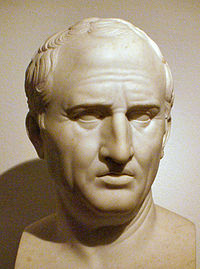






![San Jerónimo en su scriptorium, Maestro del Parral o Maestro de las Once Mil Vírgenes,[11] c. 1480-c. 1490.](https://upload.wikimedia.org/wikipedia/commons/thumb/f/fb/Master_of_Parral_-_St_Jerome_in_the_scriptorium_-_Google_Art_Project.jpg/205px-Master_of_Parral_-_St_Jerome_in_the_scriptorium_-_Google_Art_Project.jpg)

